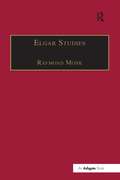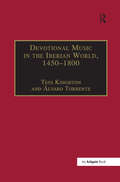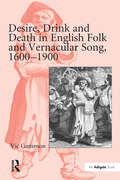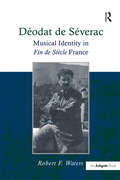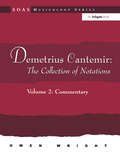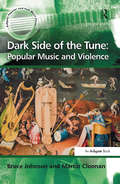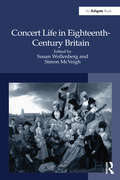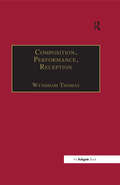- Table View
- List View
Europe, Empire, and Spectacle in Nineteenth-Century British Music
by Julian RushtonThis volume illuminates musical connections between Britain and the continent of Europe, and Britain and its Empire. The seldom-recognized vitality of musical theatre and other kinds of spectacle in Britain itself, and also the flourishing concert life of the period, indicates a means of defining tradition and identity within nineteenth-century British musical culture. The objective of the volume has been to add significantly to the growing literature on these topics. It benefits not only from new archival research, but also from fresh musicological approaches and interdisciplinary methods that recognize the integral role of music within a wider culture, including religious, political and social life. The essays are by scholars from the USA, Britain, and Europe, covering a wide range of experience. Topics range from the reception of Bach, Mozart, and Liszt in England, a musical response to Shakespeare, Italian opera in Dublin, exoticism, gender, black musical identities, British musicians in Canada, and uses of music in various theatrical genres and state ceremony, and in articulating the politics of the Union and Empire.
Europe, Empire, and Spectacle in Nineteenth-Century British Music
by Julian RushtonThis volume illuminates musical connections between Britain and the continent of Europe, and Britain and its Empire. The seldom-recognized vitality of musical theatre and other kinds of spectacle in Britain itself, and also the flourishing concert life of the period, indicates a means of defining tradition and identity within nineteenth-century British musical culture. The objective of the volume has been to add significantly to the growing literature on these topics. It benefits not only from new archival research, but also from fresh musicological approaches and interdisciplinary methods that recognize the integral role of music within a wider culture, including religious, political and social life. The essays are by scholars from the USA, Britain, and Europe, covering a wide range of experience. Topics range from the reception of Bach, Mozart, and Liszt in England, a musical response to Shakespeare, Italian opera in Dublin, exoticism, gender, black musical identities, British musicians in Canada, and uses of music in various theatrical genres and state ceremony, and in articulating the politics of the Union and Empire.
Essays on Opera, 1750-1800
by JohnA. RiceThe study of opera in the second half of the eighteenth century has flourished during the last several decades, and our knowledge of the operas written during that period and of their aesthetic, social, and political context has vastly increased. This volume explores opera and operatic life of the years 1750-1800 through a selection of articles intended to represent the last few decades of scholarship in all its excitement and variety.
Essays on Opera, 1750-1800
by JohnA. RiceThe study of opera in the second half of the eighteenth century has flourished during the last several decades, and our knowledge of the operas written during that period and of their aesthetic, social, and political context has vastly increased. This volume explores opera and operatic life of the years 1750-1800 through a selection of articles intended to represent the last few decades of scholarship in all its excitement and variety.
Embodied Knowledge in Ensemble Performance (Sempre Studies In The Psychology Of Music Ser.)
by J.Murphy McCalebPerforming in musical ensembles provides a remarkable opportunity for interaction between people. When playing a piece of music together, musicians contribute to the creation of an artistic work that is shaped through their individual performances. However, even though ensembles are a large part of musical activity, questions remain as to how they function. In Embodied Knowledge in Ensemble Performance, Murphy McCaleb explores the processes by which musicians interact with each other through performance. McCaleb begins by breaking down current models of ensemble interaction, particularly those that rely on the same kind of communication found in conversation. In order to find a new way of describing this interaction, McCaleb considers the nature of the information being shared between musicians during performance. Using examples from postgraduate ensembles at Birmingham Conservatoire as well as his own reflective practice, he examines how an understanding of the relationship between musicians and their instruments may affect the way performers infer information within an ensemble. Drawing upon research from musicology, occupational psychology, and philosophy, and including a DVD of excerpts from rehearsals and performances, Embodied Knowledge provides an holistic approach to ensemble research in a manner accessible to performers, researchers and teachers.
Embodied Knowledge in Ensemble Performance
by J.Murphy McCalebPerforming in musical ensembles provides a remarkable opportunity for interaction between people. When playing a piece of music together, musicians contribute to the creation of an artistic work that is shaped through their individual performances. However, even though ensembles are a large part of musical activity, questions remain as to how they function. In Embodied Knowledge in Ensemble Performance, Murphy McCaleb explores the processes by which musicians interact with each other through performance. McCaleb begins by breaking down current models of ensemble interaction, particularly those that rely on the same kind of communication found in conversation. In order to find a new way of describing this interaction, McCaleb considers the nature of the information being shared between musicians during performance. Using examples from postgraduate ensembles at Birmingham Conservatoire as well as his own reflective practice, he examines how an understanding of the relationship between musicians and their instruments may affect the way performers infer information within an ensemble. Drawing upon research from musicology, occupational psychology, and philosophy, and including a DVD of excerpts from rehearsals and performances, Embodied Knowledge provides an holistic approach to ensemble research in a manner accessible to performers, researchers and teachers.
Elgar Studies
by Raymond MonkEdward Elgar rose from obscurity to become the most popular English composer of his day. Elgar's music is known world-wide and works such as the 'Enigma Variations' and 'The Dream of Gerontius' together with the two symphonies and the two concertos have established him as one of the greatest British composers of all time. The Elgar Society was founded in 1951 to further the cause of Elgar's music and the present volume of essays has been compiled as an expression of gratitude for the work that it has done. These essays reflect the variety and richness of Elgar's music and the debate that this music continues to encourage. The book is not simply for academics however; lovers of music in general will find much to entertain them and it will add greatly to our appreciation of Elgar.
Elgar Studies
by Raymond MonkEdward Elgar rose from obscurity to become the most popular English composer of his day. Elgar's music is known world-wide and works such as the 'Enigma Variations' and 'The Dream of Gerontius' together with the two symphonies and the two concertos have established him as one of the greatest British composers of all time. The Elgar Society was founded in 1951 to further the cause of Elgar's music and the present volume of essays has been compiled as an expression of gratitude for the work that it has done. These essays reflect the variety and richness of Elgar's music and the debate that this music continues to encourage. The book is not simply for academics however; lovers of music in general will find much to entertain them and it will add greatly to our appreciation of Elgar.
Electronica, Dance and Club Music
by Mark J. ButlerDiscos, clubs and raves have been focal points for the development of new and distinctive musical and cultural practices over the past four decades. This volume presents the rich array of scholarship that has sprung up in response. Cutting-edge perspectives from a broad range of academic disciplines reveal the complex questions provoked by this musical tradition. Issues considered include aesthetics; agency; 'the body' in dance, movement, and space; composition; identity (including gender, sexuality, race, and other constructs); musical design; place; pleasure; policing and moral panics; production techniques such as sampling; spirituality and religion; sub-cultural affiliations and distinctions; and technology. The essays are contributed by an international group of scholars and cover a geographically and culturally diverse array of musical scenes.
Electronica, Dance and Club Music
by MarkJ. ButlerDiscos, clubs and raves have been focal points for the development of new and distinctive musical and cultural practices over the past four decades. This volume presents the rich array of scholarship that has sprung up in response. Cutting-edge perspectives from a broad range of academic disciplines reveal the complex questions provoked by this musical tradition. Issues considered include aesthetics; agency; 'the body' in dance, movement, and space; composition; identity (including gender, sexuality, race, and other constructs); musical design; place; pleasure; policing and moral panics; production techniques such as sampling; spirituality and religion; sub-cultural affiliations and distinctions; and technology. The essays are contributed by an international group of scholars and cover a geographically and culturally diverse array of musical scenes.
Editing Music in Early Modern Germany
by SusanLewis HammondEditing Music in Early Modern Germany argues that editors played a critical role in the transmission and reception of Italian music outside Italy. Like their counterparts in the world of classical learning, Renaissance music editors translated texts and reworked settings from Venetian publications, adapting them to the needs of northern audiences. Their role is most evident in the emergence of the anthology as the primary vehicle for the distribution of madrigals outside Italy. As a publication type that depended upon the judicious selection and presentation of material, the anthology showcased editorial work. Anthologies offer a valuable case study for examining the impact of editorial decision-making on the cultivation of particular styles, genres, authors and audiences. The book suggests that music editors defined the appropriation of Italian music through the same processes of adaptation, transformation and domestication evident in the broader reception of Italy north of the Alps. Through these studies, Susan Lewis Hammond's work reassesses the importance of northern Europe in the history of the madrigal and its printing. This book will be the first comprehensive study of editors as a distinct group within the network of printers, publishers, musicians and composers that brought the madrigal to northern audiences. The field of Renaissance music printing has a long and venerable scholarly tradition among musicologists and music bibliographers. This study will contribute to recent efforts to infuse these studies with new approaches to print culture that address histories of reading and listening, patronage, marketing, transmission, reception, and their cultural and political consequences.
Editing Music in Early Modern Germany
by SusanLewis HammondEditing Music in Early Modern Germany argues that editors played a critical role in the transmission and reception of Italian music outside Italy. Like their counterparts in the world of classical learning, Renaissance music editors translated texts and reworked settings from Venetian publications, adapting them to the needs of northern audiences. Their role is most evident in the emergence of the anthology as the primary vehicle for the distribution of madrigals outside Italy. As a publication type that depended upon the judicious selection and presentation of material, the anthology showcased editorial work. Anthologies offer a valuable case study for examining the impact of editorial decision-making on the cultivation of particular styles, genres, authors and audiences. The book suggests that music editors defined the appropriation of Italian music through the same processes of adaptation, transformation and domestication evident in the broader reception of Italy north of the Alps. Through these studies, Susan Lewis Hammond's work reassesses the importance of northern Europe in the history of the madrigal and its printing. This book will be the first comprehensive study of editors as a distinct group within the network of printers, publishers, musicians and composers that brought the madrigal to northern audiences. The field of Renaissance music printing has a long and venerable scholarly tradition among musicologists and music bibliographers. This study will contribute to recent efforts to infuse these studies with new approaches to print culture that address histories of reading and listening, patronage, marketing, transmission, reception, and their cultural and political consequences.
Devotional Music in the Iberian World, 1450-1800: The Villancico and Related Genres
by TESS KNIGHTON AND ÁLVARO TORRENTEFrom the fifteenth century to the beginning of the nineteenth century, devotional music played a fundamental role in the Iberian world. Songs in the vernacular, usually referred to by the generic name of 'villancico', but including forms as varied as madrigals, ensaladas, tonos, cantatas or even oratorios, were regularly performed at many religious feasts in major churches, royal and private chapels, convents and in monasteries. These compositions appear to have progressively fulfilled or supplemented the role occupied by the Latin motet in other countries and, as they were often composed anew for each celebration, the surviving sources vastly outnumber those of Latin compositions; they can be counted in tens of thousands. The close relationship with secular genres, both musical, literary and performative, turned these compositions into a major vehicle for dissemination of vernacular styles throughout the Iberian world. This model of musical production was also cultivated in Portugal and rapidly exported to the Spanish and Portuguese colonies in America and Asia. In many cases, the villancico repertory represents the oldest surviving source of music produced in these regions, thus affording it a primary role in the construction of national identities. The sixteen essays in this volume explore the development of devotional music in the Iberian world in this period, providing the first broad-based survey of this important genre.
Devotional Music in the Iberian World, 1450-1800: The Villancico and Related Genres
by Tess KnightonFrom the fifteenth century to the beginning of the nineteenth century, devotional music played a fundamental role in the Iberian world. Songs in the vernacular, usually referred to by the generic name of 'villancico', but including forms as varied as madrigals, ensaladas, tonos, cantatas or even oratorios, were regularly performed at many religious feasts in major churches, royal and private chapels, convents and in monasteries. These compositions appear to have progressively fulfilled or supplemented the role occupied by the Latin motet in other countries and, as they were often composed anew for each celebration, the surviving sources vastly outnumber those of Latin compositions; they can be counted in tens of thousands. The close relationship with secular genres, both musical, literary and performative, turned these compositions into a major vehicle for dissemination of vernacular styles throughout the Iberian world. This model of musical production was also cultivated in Portugal and rapidly exported to the Spanish and Portuguese colonies in America and Asia. In many cases, the villancico repertory represents the oldest surviving source of music produced in these regions, thus affording it a primary role in the construction of national identities. The sixteen essays in this volume explore the development of devotional music in the Iberian world in this period, providing the first broad-based survey of this important genre.
Desire, Drink and Death in English Folk and Vernacular Song, 1600-1900
by Vic GammonThis much-needed book provides valuable insights into themes and genres in popular song in the period c. 1600-1900. In particular it is a study of popular ballads as they appeared on printed sheets and as they were recorded by folk song collectors. Vic Gammon displays his interest in the way song articulates aspects of popular mentality and he relates the discourse of the songs to social history. Gammon discusses the themes and narratives that run through genres of song material and how these are repeated and reworked through time. He argues that in spite of important social and economic changes, the period 1600-1850 had a significant cultural consistency and characteristic forms of popular musical and cultural expression. These only changed radically under the impact of industrialization and urbanization in the nineteenth century. The book will appeal to those interested in folk song, historical popular music (including church music), ballad literature, popular literature, popular culture, social history, anthropology and sociology.
Desire, Drink and Death in English Folk and Vernacular Song, 1600-1900
by Vic GammonThis much-needed book provides valuable insights into themes and genres in popular song in the period c. 1600-1900. In particular it is a study of popular ballads as they appeared on printed sheets and as they were recorded by folk song collectors. Vic Gammon displays his interest in the way song articulates aspects of popular mentality and he relates the discourse of the songs to social history. Gammon discusses the themes and narratives that run through genres of song material and how these are repeated and reworked through time. He argues that in spite of important social and economic changes, the period 1600-1850 had a significant cultural consistency and characteristic forms of popular musical and cultural expression. These only changed radically under the impact of industrialization and urbanization in the nineteenth century. The book will appeal to those interested in folk song, historical popular music (including church music), ballad literature, popular literature, popular culture, social history, anthropology and sociology.
Déodat de Séverac: Musical Identity in Fin de Siècle France
by RobertF. WatersD�at de S�rac (1872-1921) is best known for his piano music but his compositions included orchestral and vocal works, including opera, cantata and incidental music. Claude Debussy described S�rac's music as "exquisite and rich with ideas." The early works were influenced by Impressionist harmonies, church modes, cyclic techniques, folk-like melodies and Andalusian motives. S�rac's style changed dramatically in 1907 when he left Paris and began to include Catalan elements in his compositions - a transition that has hitherto gone unrecognized. Robert Waters provides a much-needed study of the life and works of S�rac, focusing on the composer's regionalist philosophy. S�rac's engagement with folk music was not a patriotic gesture in the vein of nationalistic composers, but a way of expressing regional identity within France to counter the restrictive styles sanctioned by the Paris Conservatory. His musical philosophy mirrored larger social and political debates regarding anti-centralist positions on education, politics, art and culture in fin de siecle France. Such debates involved political and social leaders whom S�rac knew and personally admired, including the writer Maurice Barr�and the poet Fr�ric Mistral. The book will appeal to those specializing in French music, European ethnic musics, piano music and French music history.
Déodat de Séverac: Musical Identity in Fin de Siècle France
by RobertF. WatersD�at de S�rac (1872-1921) is best known for his piano music but his compositions included orchestral and vocal works, including opera, cantata and incidental music. Claude Debussy described S�rac's music as "exquisite and rich with ideas." The early works were influenced by Impressionist harmonies, church modes, cyclic techniques, folk-like melodies and Andalusian motives. S�rac's style changed dramatically in 1907 when he left Paris and began to include Catalan elements in his compositions - a transition that has hitherto gone unrecognized. Robert Waters provides a much-needed study of the life and works of S�rac, focusing on the composer's regionalist philosophy. S�rac's engagement with folk music was not a patriotic gesture in the vein of nationalistic composers, but a way of expressing regional identity within France to counter the restrictive styles sanctioned by the Paris Conservatory. His musical philosophy mirrored larger social and political debates regarding anti-centralist positions on education, politics, art and culture in fin de siecle France. Such debates involved political and social leaders whom S�rac knew and personally admired, including the writer Maurice Barr�and the poet Fr�ric Mistral. The book will appeal to those specializing in French music, European ethnic musics, piano music and French music history.
Demetrius Cantemir: Volume 2: Commentary
by Owen WrightThe substantial collection of notations of seventeenth-century Ottoman instrumental music made by Demetrius Cantemir is both a record of compositions of considerable intrinsic interest and a historical document of vital importance, representing as it does one of the most comprehensive accounts of any Middle Eastern repertoire before the widespread adoption of Western notation in the twentieth century. This volume contains a commentary to the edition of Cantemir's notations prepared by the same author. The introductory section provides a context for the collection, giving a biographical sketch of its compiler and relating it to the theoretical treatise it accompanies. This is followed by a substantial analysis of modal structures which examines each makam individually and then attempts to make progressively wider generalizations. The projection of melody onto the various rhythmic cycles is next examined, with particular attention being paid to the various formulaic elements which constitute much of the compositional language of the period. A final section shifts to a more diachronic perspective, surveying internal evidence for historical change and for the survival of earlier styles.
Demetrius Cantemir: Volume 2: Commentary
by Owen WrightThe substantial collection of notations of seventeenth-century Ottoman instrumental music made by Demetrius Cantemir is both a record of compositions of considerable intrinsic interest and a historical document of vital importance, representing as it does one of the most comprehensive accounts of any Middle Eastern repertoire before the widespread adoption of Western notation in the twentieth century. This volume contains a commentary to the edition of Cantemir's notations prepared by the same author. The introductory section provides a context for the collection, giving a biographical sketch of its compiler and relating it to the theoretical treatise it accompanies. This is followed by a substantial analysis of modal structures which examines each makam individually and then attempts to make progressively wider generalizations. The projection of melody onto the various rhythmic cycles is next examined, with particular attention being paid to the various formulaic elements which constitute much of the compositional language of the period. A final section shifts to a more diachronic perspective, surveying internal evidence for historical change and for the survival of earlier styles.
Dark Side of the Tune: Popular Music and Violence (Ashgate Popular And Folk Music Ser.)
by Martin CloonanWritten against the academically dominant but simplistic romanticization of popular music as a positive force, this book focuses on the 'dark side' of the subject. It is a pioneering examination of the ways in which popular music has been deployed in association with violence, ranging from what appears to be an incidental relationship, to one in which music is explicitly applied as an instrument of violence. A preliminary overview of the physiological and cognitive foundations of sounding/hearing which are distinctive within the sensorium, discloses in particular their potential for organic and psychic violence. The study then elaborates working definitions of key terms (including the vexed idea of the 'popular') for the purposes of this investigation, and provides a historical survey of examples of the nexus between music and violence, from (pre)Biblical times to the late nineteenth century. The second half of the book concentrates on the modern era, marked in this case by the emergence of technologies by which music can be electronically augmented, generated, and disseminated, beginning with the advent of sound recording from the 1870s, and proceeding to audio-internet and other contemporary audio-technologies. Johnson and Cloonan argue that these technologies have transformed the potential of music to mediate cultural confrontations from the local to the global, particularly through violence. The authors present a taxonomy of case histories in the connection between popular music and violence, through increasingly intense forms of that relationship, culminating in the topical examples of music and torture, including those in Bosnia, Darfur, and by US forces in Iraq and Guant mo Bay. This, however, is not simply a succession of data, but an argumentative synthesis. Thus, the final section debates the implications of this nexus both for popular music studies itself, and also in cultural policy and regulation, the ethics of citizenship, and arguments about human
Dark Side of the Tune: Popular Music and Violence
by Martin CloonanWritten against the academically dominant but simplistic romanticization of popular music as a positive force, this book focuses on the 'dark side' of the subject. It is a pioneering examination of the ways in which popular music has been deployed in association with violence, ranging from what appears to be an incidental relationship, to one in which music is explicitly applied as an instrument of violence. A preliminary overview of the physiological and cognitive foundations of sounding/hearing which are distinctive within the sensorium, discloses in particular their potential for organic and psychic violence. The study then elaborates working definitions of key terms (including the vexed idea of the 'popular') for the purposes of this investigation, and provides a historical survey of examples of the nexus between music and violence, from (pre)Biblical times to the late nineteenth century. The second half of the book concentrates on the modern era, marked in this case by the emergence of technologies by which music can be electronically augmented, generated, and disseminated, beginning with the advent of sound recording from the 1870s, and proceeding to audio-internet and other contemporary audio-technologies. Johnson and Cloonan argue that these technologies have transformed the potential of music to mediate cultural confrontations from the local to the global, particularly through violence. The authors present a taxonomy of case histories in the connection between popular music and violence, through increasingly intense forms of that relationship, culminating in the topical examples of music and torture, including those in Bosnia, Darfur, and by US forces in Iraq and Guant mo Bay. This, however, is not simply a succession of data, but an argumentative synthesis. Thus, the final section debates the implications of this nexus both for popular music studies itself, and also in cultural policy and regulation, the ethics of citizenship, and arguments about human
Concert Life in Eighteenth-Century Britain
by Susan Wollenberg and Simon McVeighIn recent years there has been a considerable revival of interest in music in eighteenth-century Britain. This interest has now expanded beyond the consideration of composers and their music to include the performing institutions of the period and their relationship to the wider social scene. The collection of essays presented here offers a portrayal of concert life in Britain that contributes greatly to the wider understanding of social and cultural life in the eighteenth century. Music was not merely a pastime but was irrevocably linked with its social, political and literary contexts. The perspectives of performers, organisers, patrons, audiences, publishers, copyists and consumers are considered here in relation to the concert experience. All of the essays taken together construct an understanding of musical communities and the origins of the modern concert system. This is achieved by focusing on the development of music societies; the promotion of musical events; the mobility and advancement of musicians; systems of patronage; the social status of musicians; the repertoire performed and published; the role of women pianists and the 'topography' of concerts. In this way, the book will not only appeal to music specialists, but also to social and cultural historians.
Concert Life in Eighteenth-Century Britain
by Susan WollenbergIn recent years there has been a considerable revival of interest in music in eighteenth-century Britain. This interest has now expanded beyond the consideration of composers and their music to include the performing institutions of the period and their relationship to the wider social scene. The collection of essays presented here offers a portrayal of concert life in Britain that contributes greatly to the wider understanding of social and cultural life in the eighteenth century. Music was not merely a pastime but was irrevocably linked with its social, political and literary contexts. The perspectives of performers, organisers, patrons, audiences, publishers, copyists and consumers are considered here in relation to the concert experience. All of the essays taken together construct an understanding of musical communities and the origins of the modern concert system. This is achieved by focusing on the development of music societies; the promotion of musical events; the mobility and advancement of musicians; systems of patronage; the social status of musicians; the repertoire performed and published; the role of women pianists and the 'topography' of concerts. In this way, the book will not only appeal to music specialists, but also to social and cultural historians.
Composition, Performance, Reception: Studies in the Creative Process in Music
by Wyndham ThomasComposers, performers, listeners, critics and theorists all play vital roles in the creation of music culture; yet often each group can appear to hold widely divergent views of a musical work‘s aims and effects. As the title indicates, this book examines the parts played by these groups and the interaction between them. In the first of eleven essays, Robert Saxton discusses the difficulty in pin-pointing the moment of inspiration for a new composition; while Raymond Warren looks at the problems facing operatic performers, including those that arise when interpretations are suggested by the libretto but not in the music. The changing perception of the composer's art from the 14th century to the present day is charted by Wyndham Thomas, in particular attitudes towards arrangement. Two quite different views of the performer‘s responsibility in communicating the composer‘s intentions are taken by Charles Rosen and Susan Bradshaw, the latter arguing for the need to bridge the gap between theoretical and practical analysis of a work; and in two fascinating case studies, Eric Clarke and Jennifer Davidson highlight the ways in which attention to movements of the body in performance can reveal aspects of musical structure. The reception of music is tackled from a variety of perspectives in the book. In his assessment of audience reaction to Jonathan Harvey‘sThe Riot Adrian Beaumont concludes that our response is influenced by a complex web of expectations and previous musical experience. The influence of record sleeves in also determining a listener‘s response to music is discussed by Nicholas Cook; while Stephen Walsh and Adrian Thomas explore two milieux of critical reception - the first to the music of Stravinsky, and the second to works composed during the social-realist period in Poland. On a more personal level, Bojan Bujic‘s essay forms a fitting counterpart to Saxton‘s in his attempt to locate the ways in which we experience a new musica



